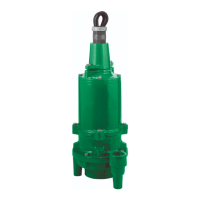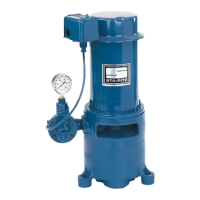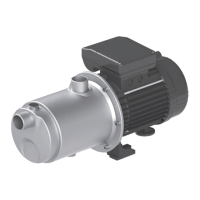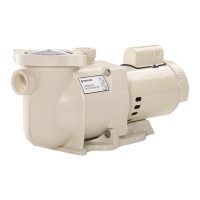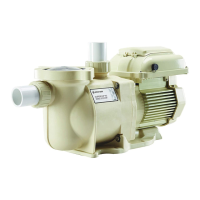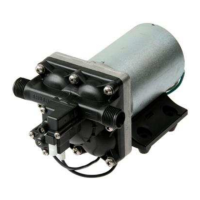26850A002 06/04/14
13
Explanation of the Service Chart
1. Pump priming is usually not necessary when the
pump is installed correctly. However, there are certain
conditions which may make it necessary to prime
the pump to get the pumping action started. Priming
will be required when it is impossible for the piston to
displace the air in the pump and replace it with water.
This could be caused by a high suction lift, the valves
being stuck on the seat or by valves sticking due to
extreme corrosion. A pump will not prime readily if
someone has tampered with the valve springs causing
them to exert undue pressure of the valve plates
against the valve seats.
2. A gate valve is sometimes installed in the suction
line between a tank or pressure line and the pump
sediment chamber. It will shut off the supply source
in order to clean the sediment chamber or to perform
pump repairs. If this valve is partially or fully closed,
it will interfere with the flow of water to the pump
suction. This also may cause severe knocking and
vibration of the pump because the water cannot flow
into the cylinder cavities fast enough.
3. A sediment chamber should be installed in the suction
line between the gate valve and the pump suction. The
strainers in these sediment chambers are to allow a
free flow of liquid to the pump. If the strainers become
severely clogged, they will completely stop the flow of
liquid to the pump.
4. Any piston pump operating at a high pressure will not
perform properly or quietly if a mixture of air and water
is allowed to enter the pump suction. A small air leak
in the suction line will cause the pump to knock and
vibrate excessively by allowing the pump to draw a
certain amount of water mixed with air on each stroke
of the piston. A large air leak will cause the pump to
lose prime after which it cannot be reprimed until the
air leak is stopped. Air leaks may occur at the joints of
the suction line piping, at the gate valve in the suction
line, at the gasket sealing the cap on the sediment
chamber, by a crack in the suction wall of the cylinder
body, or by air drawing past the packing on the suction
stroke if the packing is badly worn.
THE PUMP MUST BE INSTALLED WITH A PRESSURE RELIEF VALVE IN DISCHARGE LINE
TROUBLESHOOTING
Pump fails to build pressure with discharge closed
Failure to hold pressure with discharge open
Pump is noisy
Pump gets hot
Pressure gauge shows abnormal fluctuation
POSSIBLE CAUSE OF PROBLEM
1. Pump not primed X
2. Valve closed in suction line X X
3. Suction line or sediment chamber clogged X X X
4. Air leak in suction line X X X
5. Pressure regulator valve badly worn or not properly adjusted X X
6. Broken valves or springs X X X
7. Pump packing or valves badly worn X X X
8. Pressure regulator bypassed by open #1 valve X X
9. Pump cylinder body cracked X X X
10. Water in crankcase X
11. Worn connecting link inserts or wrist pin bushings X X
12. Lack of oil in crankcase X X
13. Foaming mixture in tank X X X
14. Regulator plunger sticking X
15. Foreign matter under pump valve X X X
16. Loose piston rod X
17. Improper preload of crankshaft bearings X X
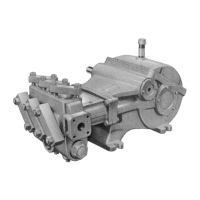
